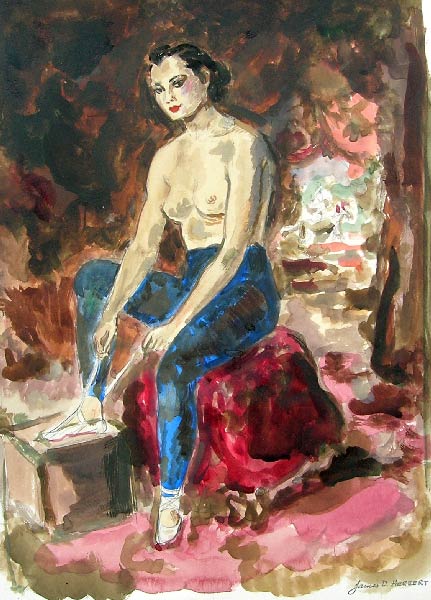Ballets Russes

View Exhibit
Ballets Russes
Costume, Dance, and Modern Art
Between 1909 and 1929, the Ballets Russes had a wildly successful run, founded in Paris and later throughout Europe, under the direction of Serge Diaghilev. The company not only revolutionized the world of dance, but also had tremendous influence on the art world, collaborating with prominent artists such as Pablo Picasso and Georges Braque. Movements of the time such as Expressionism and Cubism were reflected in the performances through costume and set design and musical composition. Diaghilev’s goal was to bring together artists of different media and create an experience in which the “overall impact surpassed the parts.”
Many American artists visited Paris during this time, including James Drummond Herbert, who studied at the Academie Julian during the 1920’s and was profoundly influenced by his colleagues. His sketches and paintings of dancers and performers reflect these modern innovative styles.
Costume
While costume design for the Ballets Russes was initially dominated by Russian aesthetics, designers began to incorporate exotic influences resulting in colorful, striking, and innovative creations. These exciting costumes helped to transform the dancers into completely new characters.
Herbert embraces these exotic influences in his work while also considering the American style sensibilities of the time. In the 1940’s, Herbert was commissioned by the National Ballet Company in New York to create designs for some of its performances.
The Dancer
While Herbert portrayed the on-stage theatrics of a show in his work, he was interested in capturing the dancers in a state of rest and contemplation. He removes the artifice of performance to study the figures as individuals, not merely a construction of the director.
Clowns, Harlequins and Jesters
Clowns, harlequins, and jesters have long been a subject of artistic representation, engrained in the European cultural tradition. Originally part of traveling troupes, these characters were also portrayed in ballets and operas. Depictions range from humorous court jesters, to “Pierrot”, the sad clown, to the motley harlequin.
The position of these characters was to entertain and tell a story, but also to provide insight and commentary through humor.
James Herbert portrays these traditional characters in many of his works, infusing them with a blend of European and American themes and aesthetics.
Scene
The setting for each production of the Ballets Russes was an integral part or the performance, as they were considered a complete work of art, rather than a simple recital of dance. Particular attention was given to backdrops and set design, employing the artistic prowess of renown artists of the time, notably Pablo Picasso, who created his largest known canvas, “Le Train Bleu” for a 1924 performance.
James Herbert demonstrates the importance of creating a visual setting in which to place his characters to create a dynamic scene and transport the audience to a different world.